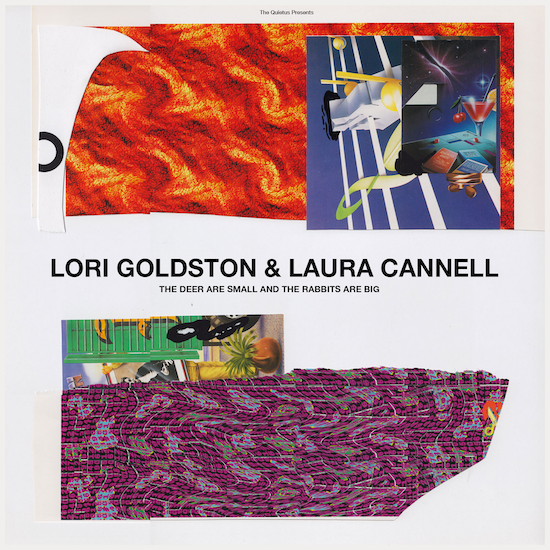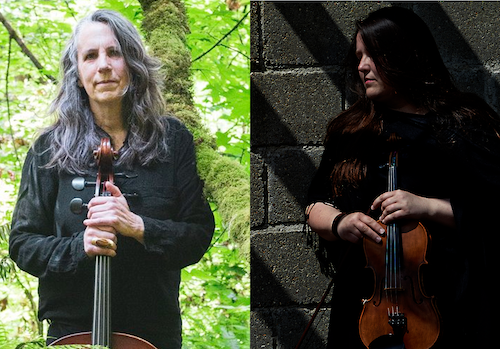Lori Goldston by Jenny Riffle, Laura Cannell by Andy Sapey photography
There are over 600 churches in East Anglia, some dating back to the eleventh century. With distinctive flint construction, most are a legacy of the region’s wealth from the Medieval wool trade. These ancient buildings often have wonderful acoustics, and where priests once preached hellfire, damnation and eternal life, they now resound to music that sits between the ancient and modern. At the height of this year’s brutal midsummer heatwave, they also provided a cool and quiet place to record, a fact multi-instrumentalist Laura Cannell and cellist Lori Goldston took advantage of this July when they recorded The Deer Are Small, And The Rabbits Are Big, now available exclusively to our Sound + Vision subscribers.
2022 has already turned out to be a busy year for both Cannell and Goldston. In March, the former released the mesmerising Antiphony Of The Trees, which was named among The Quietus’ favourites of the year so far, and in the following months two more albums: Unlocking Rituals and We Long to Be Haunted via Brawl Records, which she founded in 2005. Goldston has just released the solo album High And Low for amplified cello. Goldston was initially trained in classical music on cello and guitar, but later switched to playing cello in rock bands and improvising with both jazz and classical musicians, including Earth, David Byrne, and Greg Kelley. In 1994, she participated in Nirvana’s MTV Unplugged sessions. It turns out that the spark of this collaboration happened when Cannell first saw that legendary performance. The acoustic Nirvana concert played a big role in changing people’s views on classical instruments, Goldston recalls. “People could look at it and say ‘Okay, there’s someone who’s not in the orchestra!’” Cannell remembers the moment she saw that show. “I watched it and thought, “Oh my God, I don’t have to play this instrument and be a classical musician!” And so from this formative moment in the mid-90s to The Deer Are Small, And The Rabbits Are Big.
The title might suggest a fairy tale, but the story behind it embeds the album firmly in East Anglia. After recording the album, the two musicians were driving in the area when they realised that they could hear muntjacs barking in the woods. “There were these very small deer and these very large rabbits – it became kind of an ongoing joke,” says Goldston. “The title references the feeling when you’re travelling and things are partly familiar, but also a bit ‘off’ and feel a bit surreal.”
The two musicians have known each other for eight years, meeting when Seattle-based Goldstein travelled to London for a gig at Cafe OTO where Cannell was in attendance. and afterwards they spent a long time talking and decided to stay in touch. Three years later they arranged to play a few shows together. “At each venue, I just took my Zoom H4 with me and recorded,” Cannell recalls. “It was completely organic. We just played and let the music do what it wanted to do.” This would eventually reveal itself as the prelude to The Deer Are Small, And The Rabbits Are Big.
This summer Goldston was on tour across Europe, and they made time to catch up once again. “I was very excited to be able to play in these very old spaces that just don’t exist in the US,” says Goldston, “It’s a totally exotic thing to play in a Medieval church, and they’re just everywhere.”
The duo in fact recorded at two churches, five miles apart from one another in Norfolk: the 12th century St Andrew’s Church in Raveningham, which still serves local people, and the remains of St Olave’s Priory founded by the River Waveney in 1216.
The names of these places appear in the track titles of their new album, and their atmosphere is reflected in the music. ‘Vaulted Echoes’ begins with Cannell’s resonant violin ostinato counterpointed by the heavy bowing of Goldston’s cello. These intense and punctuated motifs become more varied in ‘Sheltered In The Undercroft’ which embodies the mysteries of the space in which it was recorded, St. Olave’s ancient cellar. On ‘Devil White Flowers’, Cannell’s voice adds to the unique atmosphere of the undercroft. The lyrics for this song were the only thing that was planned ahead of time to any extent. “The words were taken from an eighteenth century collection of East Anglian proverbs and folk sayings. I took bits and pieces of them and then showed them to Lori,” says Cannell. “Then we both used them as a graphic score or prompts.”

Cannell took some of the words and wandered around the space. She and Goldston had one microphone that they placed in the middle of the room to see what happened. “I’m not the most confident in my singing, but I really wanted to use my voice, to treat it like an instrument and see how it works with Lori,” says Cannell. “These spaces are so acoustically beautiful and complex,” adds Goldston. “Each of them is clearly really well thought out but also has a distinct set of parameters. For me, it was cool to explore that space sonically, and the fact that Laura was very familiar with that space sonically as well was great.” Raveningham, where St Andrew’s Church is located, is local to where Cannell grew up. She has recorded several solo albums and some of her other projects within the same church walls.
While the compositions explore the possibilities of stringed instruments, they also show the sonic qualities of Medieval spaces. ‘The Underground Passage’ was recorded in a hidden pathway. In this composition, chiselled violin parts are undermined by the sound of the cello to create phrases that dissolve into space. ‘They Roamed the Summer Tundra’, on the other hand, sounds the most folk-like of all the songs with its minimalist, marching cello motifs.
“I love acoustic instruments in general – it seems very important to me to keep them in the future,” says Goldston. “I think they’re probably the most magical thing human beings have ever invented, and they should remain very much alive, vibrant, and central to our lives, no matter how many synthesisers or online gigs there are. There’s nothing like an acoustic instrument. It’s the best thing people have ever come up with.”
Both musicians are determined to keep their instruments in a contemporary framework. Though sometimes described as one, Cannell doesn’t think of herself as a folk musician, preferring to keep her music genreless. Self-taught, she started with traditional music and then realised that it just wasn’t enough on its own. The next stage of her journey was writing her own music, overbowing the violin, and approaching the instrument as something new. “I always think of it as creating my own traditions. It’s like all the music has come in and pulled the fingers back.”
“You can have a lot of people who can make an instrument sound a very particular way, but it’s about making it something that conveys your feeling,” says Goldston. The instrument might have its limitations, “but the more you’re honest with yourself, the more you can find different colours, tones, I just want to get away from what I think I should be doing.”
To receive the new EP by Laura Cannell and Lori Goldston, as well as a host of other benefits including exclusive essays, podcasts and playlists, and loads more specially-comissioned music, become a Quietus Sound + Vision subscriber. You can do so here



